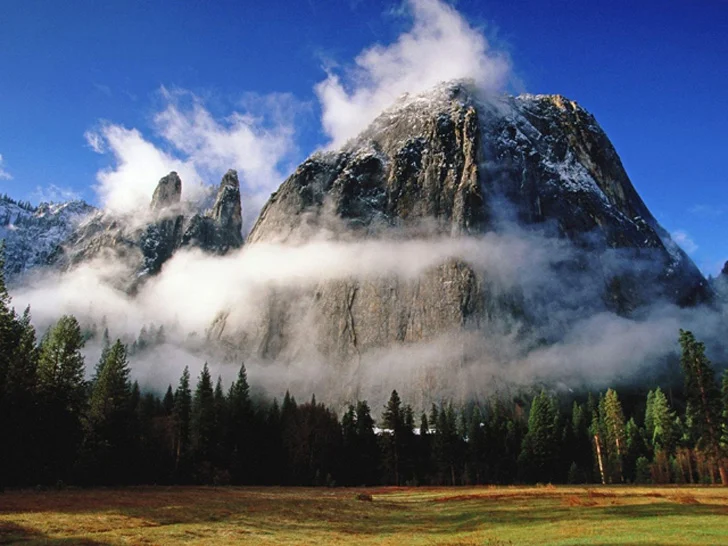It may be popular for its unbelievable valleys, but Yosemite is much
more than a valley. In fact, it is home to some of the nation’s most
spectacular waterfalls, meadows, and ancient sequoia trees. Within its
1,200 miles of wilderness, visitors can find everything nature defines
as beauty—wild flowers, animals grazing, crystal clear lakes, and
amazing domes and pinnacles of granite.
History
During
the same time that Yellowstone became the first national park, Yosemite
Valley and Mairposa Grove were recognized as state parks within
California. When the National Park Service was formed in 1916, Yosemite
fell under their jurisdiction. It has been use by the United States Army
and even President Theodore Roosevelt has spent time camping within its
borders. In fact, it is internationally recognized for its granite
cliffs, biological diversity, ancient trees, and enormous waterfalls.
[post_ads_2]
Today, the park spans three counties and covers 761,266 acres.
It is one of the largest blocks in the Sierra
Nevada mountain chain, and is home to a diversity of plants and animals.
Yosemite helped pave the way for conservation and recognition of
national parks, and is one that cannot be missed.
When to Visit
Open
year-round, this national park fills up quickly on holiday weekends.
You can expect to find filled campgrounds from June through August.
Spring and autumn sometimes draw in more tourists, but still prove to be
the best seasons to plan your trip.
Getting There
If
you are traveling from the northeast, take Calif. 120 to the Tioga Pass
Entrance. Note: This entrance may be closed during late May to
mid-November, depending on the weather.
[post_ads_2]
From the south, follow Calif. 41 until you reach the South Entrance.
Your
best bet is to travel to Merced, a gateway community for Yosemite
located about 70 miles away. From Merced, follow Calif. 140 to the Arch
Rock Entrance.
Fees/Permits
An entrance
fee applies to all visitors. For a private, non-commercial vehicle, the
fee is $20 and includes all passengers. This is valid for unlimited
entries to Yosemite for seven days. Those arriving by foot, bike,
motorcycle, or horseback will be charge $10 to enter.
An annual Yosemite pass can be purchased for $40, and other standard passes may be used as well.
Reservations are only needed if you plan to spend the night in the park.
Major Attractions
Do
not miss the highest waterfall in North America—Yosemite Falls, at
2,425 feet. Choose between trails leading up to Lower Yosemite Falls or
Upper Yosemite Falls, but keep in mind the latter is more strenuous.
Plan
at least a half day to enjoy Mariposa Grove, home to more than 200
sequoia trees. The most well-known is Grizzly Giant, estimated to be
1,500 years old.
Also be sure to check out Half Dome, a massive
block of granite seemingly cut in half by a glacier. Sparing over 4,788
feel above the valley, it will take your breath away.
Accommodations
Overnight
backpacking and camping is popular within the park. Reservations are
required, and many permits are given on a first come, first served
basis. Thirteen campgrounds serve Yosemite, with four open all
year-round. Check out Hodgdon Meadow from the spring through fall, or
Crane Flat and Tuolumne Meadows in the summer.
[post_ads_2]
Inside the park, you can find many camps and lodges. High Sierra Camps offer five camps with tent cabins, costing $126 per person—fee includes breakfast and dinner. Yosemite Lodge is also quite popular for those seeking a rustic feel.
Areas of Interest Outside the Park
Two
California national forests are convenient to Yosemite: Stanislaus
National Forest in Sonora, and Sierra National Forest in Mariposa.
Stanislaus offers hiking, horseback riding, boating, and scenic drives
through its 898,322 acres, while Sierra boasts parts of five wilderness
areas at 1,303,037 acres. Visitors may also enjoy hiking, fishing, and
winter sports.
About three hours away, tourists can take in another national treasure—Sequoia & Kings Canyon National Park,
two national parks that joined in 1943. Nearly every square mile of
this park is considered wilderness. Enjoy stunning groves, forests,
caves, and lakes.

























